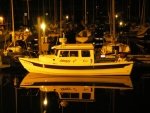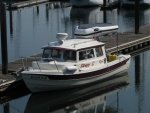d&linAK
New member
- Joined
- Jan 18, 2015
- Messages
- 21
- Reaction score
- 0
- C Dory Year
- 1994
- C Dory Model
- user_field_choice.c_dory_model_16_Angler
- Vessel Name
- Chick-A-Dee
Hi everyone, I've got a bit of a lighting issue and I was hoping to get some wisdom from the C-Brats.
I live on a small island about a 5min ride from town that I commute to and from every day. As the days get shorter we've been traveling in the dark more often and are in need of a head/spotlight for travel - we have all the necessary navigation equipment but want to be able to see deadheads and other debris in the water when crossing in the dark.
I bought a 10' LED combo Spot/flood light from Bulldog (http://store.bulldogledlighting.com/10- ... r-p/10.htm)
but it hasn't quite done what we want it to. I've tried both mounting it on the brow of the cabin and up front on the bow, but neither position gets good penetration to the surface of the water (even without much backscatter from small amount of light that hits the front of the boat). I was also looking at a one of the Rigid marine D2 Driving spotlights (http://marine.rigidindustries.com/led-lighting/70131), but I thought that the larger combo Bulldog light bar would have just as much spot light capacity as the Rigid as well as some flood capacity. But as I said, the Bulldog just seems to be very bright without really illuminating the patch of water directly in front of the boat.
Was I wrong to assume that the Bulldog combo light would be as good if not better than the dedicated Rigid Spotlight? Would the Rigid Spotlight have a much more focused beam? Or am I just searching for a non-existent perfect light for under $250.
I've read the arguments against spotlights for night travel, and I don't think the handheld option would be very practical for our needs. Thanks for your input!
I live on a small island about a 5min ride from town that I commute to and from every day. As the days get shorter we've been traveling in the dark more often and are in need of a head/spotlight for travel - we have all the necessary navigation equipment but want to be able to see deadheads and other debris in the water when crossing in the dark.
I bought a 10' LED combo Spot/flood light from Bulldog (http://store.bulldogledlighting.com/10- ... r-p/10.htm)
but it hasn't quite done what we want it to. I've tried both mounting it on the brow of the cabin and up front on the bow, but neither position gets good penetration to the surface of the water (even without much backscatter from small amount of light that hits the front of the boat). I was also looking at a one of the Rigid marine D2 Driving spotlights (http://marine.rigidindustries.com/led-lighting/70131), but I thought that the larger combo Bulldog light bar would have just as much spot light capacity as the Rigid as well as some flood capacity. But as I said, the Bulldog just seems to be very bright without really illuminating the patch of water directly in front of the boat.
Was I wrong to assume that the Bulldog combo light would be as good if not better than the dedicated Rigid Spotlight? Would the Rigid Spotlight have a much more focused beam? Or am I just searching for a non-existent perfect light for under $250.
I've read the arguments against spotlights for night travel, and I don't think the handheld option would be very practical for our needs. Thanks for your input!


